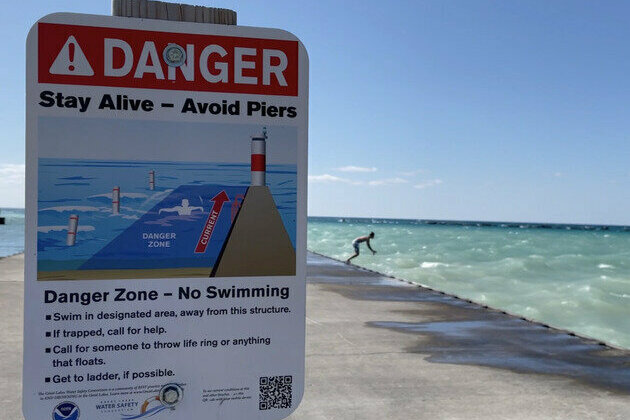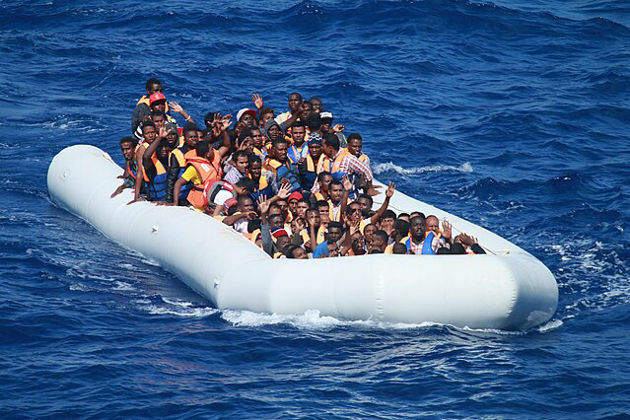The Great Lakes are powerful. Learning about 'rip currents' can help prevent drowning
The Conversation
09 Jul 2025, 15:03 GMT+10

Between 2010 and 2017, there were approximately 50 drowning fatalities each year associated with rough surf and strong currents in the Great Lakes.
In addition to the personal loss experienced by family and friends, these drownings create an annual economic burden on the regional economy of around US$105 million, and that doesn't include the direct costs of search and rescue.
Rip currents - commonly referred to as rips or colloquially as rip tides - are driven by the breaking of waves. These currents extend away from the shoreline and can flow at speeds easily capable of carrying swimmers far from the beach.
Structural rips are common throughout the Great Lakes (Grand Haven on the eastern shore of Lake Michigan, for example) and develop when groynes, jetties and rock structures deflect the alongshore current offshore, beyond the breaking waves. Depending on the waves and the structure, a shadow rip can also develop on the other side of the groyne or jetty.
Rips can also develop anywhere that variations in the bathymetry (the topography of the sand underwater) - such as nearshore bars - causes wave-breaking to vary along the beach, which makes the water thrown landward by the breaking waves return offshore as a concentrated flow at the water's surface. These are known as channel or bathymetric rips and are they can form along sand beaches in the Great Lakes.
While it can be difficult to spot a channel rip, they can be identified by an area of relatively calm water between breaking waves, a patch of darker water or the offshore flow of water, sediment and debris.
A person caught in a rip is transported away from shore into deeper water, but they are not pulled under the water. If they are a weak swimmer or try to fight the current, they may panic and fail to find a way out of the rip and back to shore before submerging.
Most rip fatalities occur on unsupervised beaches or on supervised beaches when and where lifeguards are not present. While many popular beaches near large urban centres have lifeguards, many beaches don't. Along just the east coast of Lake Huron, there are more than 40 public beaches, including Goderich, Bayfield, Southampton and Sauble Beach, but only two have lifeguard programs (Sarnia and Grand Bend).
Simple warning signs are used on many beaches, but visitors either don't pay attention or don't know how to interpret the warning.
Non-local visitors are a high-risk group for drownings. They are less likely to make safe swimming choices than residents or regular beach-goers, because visitors are generally unfamiliar with the beach and its safety measures, have poor knowledge of beach hazards like rip currents and breaking waves and are overconfident in their swimming ability.
Recent findings from a popular beach on Lake Huron suggest that those with less experience at the beach tend to make decisions of convenience rather than based on beach safety. Residents with greater knowledge of the local hazards tend to avoid swimming near where the rip can develop.
But even when people are aware of rip currents and other beach hazards, they may not make the right decisions. Despite the presence of warnings, people's actions are greatly influenced by the behaviour of others, peer pressure and group-think. The social cost of not entering the water with the group may appear to outweigh the risk posed by entering the water.
The behaviour of beach users is affected by confirmation bias, a cognitive shortcut where a person selectively pays attention to evidence confirming their pre-existing beliefs and ignores evidence to the contrary. When someone enters the water and does not encounter strong waves or currents, they're more likely to engage in risky behaviour on their next visit to that beach or a similar beach.
Vacationers and day visitors can stay safe only if they are aware that there is the potential for rip currents and rough surf at beaches in the Great Lakes. Just because a beach is accessible and has numerous attractions does not mean it is safe.
In the United States, the National Oceanographic and Atmospheric Administration runs programs designed to educate beach users about surf and rip hazards. But Canada hasn't implemented a national beach safety strategy.
Education about rips and dangerous surf falls on the shoulders of advocates, many of whom have been impacted by a drowning in the Great Lakes. The Great Lakes Surf Rescue Project has been tracking and educating school and community groups about rip currents and rough surf in the Great Lakes since 2010.
Several new advocacy groups have started in recent years, including Kincardine Beach Safety on Lake Huron and the Rip Current Information Project on Lake Erie. Given that there is limited public interest in surf-related drownings and limited media coverage, these advocacy groups are helping to increase awareness of rip currents and rough surf across the Great Lakes.
To ensure a safe trip to the beach, beachgoers should seek out more information about rip currents and other surf hazards in the Great Lakes.
 Share
Share
 Tweet
Tweet
 Share
Share
 Flip
Flip
 Email
Email
Watch latest videos
Subscribe and Follow
Get a daily dose of Detroit Star news through our daily email, its complimentary and keeps you fully up to date with world and business news as well.
News RELEASES
Publish news of your business, community or sports group, personnel appointments, major event and more by submitting a news release to Detroit Star.
More InformationInternational
SectionDeadly July 4 flash floods renew alarm over NWS staffing shortages
WASHINGTON, D.C.: After months of warnings from former federal officials and weather experts, the deadly flash floods that struck the...
Putin fires transport chief, later found dead in suspected suicide
MOSCOW, Russia: Just hours after his sudden dismissal by President Vladimir Putin, Russia's former transport minister, Roman Starovoit,...
Thousands gather in Himalayas as Dalai Lama celebrates 90th birthday
DHARAMSHALA, India: The Dalai Lama turned 90 on July 6, celebrated by thousands of followers in the Himalayan town of Dharamshala,...
Fans perform WWII-era Fascist salute at Marko Perković’s mega concert
ZAGREB, Croatia: A massive concert by popular Croatian singer Marko Perković, known by his stage name Thompson, has drawn widespread...
U.S. Treasury Secretary says Musk should steer clear of politics
WASHINGTON, D.C.: Elon Musk's entry into the political arena is drawing pushback from top U.S. officials and investors, as his decision...
TikTok building U.S.-only app amid pressure to finalise sale
CULVER CITY, California: TikTok is preparing to roll out a separate version of its app for U.S. users, as efforts to secure a sale...
Michigan
SectionOilers, Lightning swap first-round picks Sam O'Reilly, Isaac Howard
(Photo credit: Matthew Dae Smith/Lansing State Journal / USA TODAY NETWORK via Imagn Images) The Edmonton Oilers acquired reigning...
Time to go: Orban demands von der Leyens departure
The Hungarian PM mocked the EU chief ahead of Thursdays no confidence vote over her handling of vaccine deals Hungarian Prime Minister...
Guardians seek to close series against Astros with a sweep
(Photo credit: Troy Taormina-Imagn Images) With Houston closer Josh Hader having last worked on Saturday and the Astros set for an...
Tigers eye win No. 60 in series finale vs. Rays
(Photo credit: Matt Krohn-Imagn Images) The streaking Detroit Tigers can reach the 60-win mark as early as Wednesday when they host...
The Great Lakes are powerful. Learning about 'rip currents' can help prevent drowning
Between 2010 and 2017, there were approximately 50 drowning fatalities each year associated with rough surf and strong currents in...
Report: Wizards flip Kelly Olynyk to Spurs for players, pick
(Photo credit: Wendell Cruz-Imagn Images) Washington and Kelly Olynyk barely got to know one another, as the Wizards dealt the newly...












